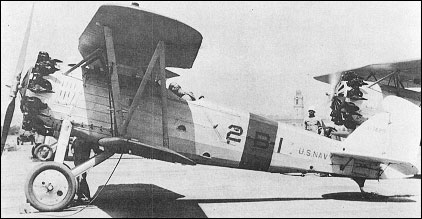|
| In April 1925 the USAAC issued a specification for a single-seat fighter to be powered by a new 447kW Packard engine of inverted layout. Boeing's airframe for this requirement was generally similar to that of the Model 15 family, but recognisable easily by an unusual feature/namely the incorporation of a coolant radiator in the
centre-section of the lower wing. Designated XP-8 (Boeing Model 66),
this failed to win a production contract.
US Navy evaluation of the FB-4 with a
Wright P-1 radial engine, which gave a
benefits of these air-cooled powerplants, led to this aircraft being re-engined with a Pratt & Whitney Wasp. Redesignated FB-6, it was flight-tested exhaustively, and demonstrated the clear superiority of the Wasp, leading to a decision to combine this engine with an airframe based on the Model 66. From this marriage of airframe and powerplant was produced the Boeing Model 69, designated XF2B-1 by the US Navy, and first flown in prototype form on 3 November 1926. It differed mainly in having the span of upper and lower wings more nearly equal, and by the propeller having a large spinner.
Satisfactory testing of the prototype resulted in an order for 32 production aircraft under the designation F2B-1, with deliveries beginning on 30 January 1928, and these served with US Navy Squadrons VF-1B (fighter) and VB-2B (bomber) on board USS Saratoga. The F2B-1s differed from the prototype by deletion of the spinner, and introduction of a balanced rudder.
 | A three-view drawing (1278 x 866) |
| MODEL | Model 69 (F2B-1) |
| ENGINE | 1 x 317kW Pratt & Whitney R-1340-B Wasp radial piston engine |
| WEIGHTS |
| Take-off weight | 1272 kg | 2804 lb |
| Empty weight | 902 kg | 1989 lb |
| DIMENSIONS |
| Wingspan | 9.17 m | 30 ft 1 in |
| Length | 6.98 m | 23 ft 11 in |
| Height | 2.81 m | 9 ft 3 in |
| Wing area | 22.57 m2 | 242.94 sq ft |
| PERFORMANCE |
| Max. speed | 254 km/h | 158 mph |
| Cruise speed | 212 km/h | 132 mph |
| Ceiling | 6555 m | 21500 ft |
| Range | 507 km | 315 miles |
| ARMAMENT | 1 x 12.7mm + 1 x 7.62mm machine-guns, 5 x 11kg bombs |
| Frank Donovan, e-mail, 24.01.2024 06:16 I am so happy to have consulted RAPID RESCORE CREDIT for my credit repairs. I discovered that I had 5 negative items on my credit most especially IRS, delayed payments and loans and over 7 hard inquiries from every bureaus and it hindered me from moving forward in my business. I could not access any loan so I started looking for ways to salvage my condition, I then discovered this specialist (RAPID RESCORE CREDIT) on reddit though there were other ones there but my instinct directed me towards Mr Jackson. I was asked for funds to get started with the job and I gave them the benefit of doubt and made some commitments. My fico score was moved from 609 to an excellent score (799) and all the negatives were deleted from my report. Right now I have a clean profile with wonderful trade lines. I’m recommending their services to anyone in dire need of credit fix, you can reach them via JACKSONRAPIDCREDITSCORE@GMAIL.COM reply | | Patrick Burnside, e-mail, 13.01.2024 01:06 Here's how I raised my FICO score from 430 to 785. My diabetic condition caused me to fall behind on my medical bills, which caused my world to fall apart. I searched high and low for someone who could help me repair my credit, but to no avail. In November of last year, I met JERRYLINK CREDIT GROUP through a friend they had worked for; they restored my dignity and boosted my credit in 9 days, allowing me to take out a loan and pay for a house. You can reach them at JERRYLINKGROUP@GMAIL.COM or via TEXT at +1 626 514 0620 reply | | Morgan Kennedy, e-mail, 10.12.2023 08:14 Mr. Jerry and I have worked together for many years now in a professional setting. I am a realtor and have clients in various stages of credit repair. Mr. Jerry is ALWAYS the person I recommend to my clients. His services are second to none & he has always done the best job in order to get my clients in a home as quick as possible when credit is holding them back. He has helped my family members, friends, & strangers I have met through my services. Thank you Mr. Jerry for caring about people like you do! You are making a difference!!! Reach out to Jerrylink Credit Group via: jerrylinkgroup@gmail.com or text 6265140620. Thank me later. reply | | Grace Peterson, e-mail, 02.12.2023 03:53 I strongly JERRYLINK CREDIT GROUP: I think they are the best in terms of credit repair. I had worked with different credit companies in the past, but there was no significant change on my credit report. So many credit forums recommended DYI, I tried every credit hack in the book all o no avail. A real estate agent introduced me to Mr. Jerry, who has been helping his clients. Mr. Jerry and his team helped me erase all the negative things on my report, and raised my score to excellent score across all three bureaus. I’m recommending as promised. They are available on gmail: JERRYLINKGROUP AT GMAIL DOT COM or +16265140620 reply | |
| | Leon Cody Garcia, e-mail, 28.11.2023 23:09 We will fix your credit; remove all negative items, clear loans, collections and hard inquiries and also raise your score to 760+ ASAP. These were the exact words from M. Jerry when I contacted him via JERRYLINKGROUP at GMAIL dot COM. I decided to give JERRYLINK CREDIT GROUP a try and to my greatest surprise it worked out for me. In less than 11days after all documentation; my score drastically increased to 810 across the three national credit bureaus (Equifax, Experian and TransUnion), I could no longer sight evidence of collections, negative marks, mortgage loan, collections and hard inquiries on my credit report. I honestly appreciate Mr. Jerry for fixing my credit. reply |
|
Do you have any comments?
|
| 
COMPANY
PROFILE
All the World's Rotorcraft
|








20
reply